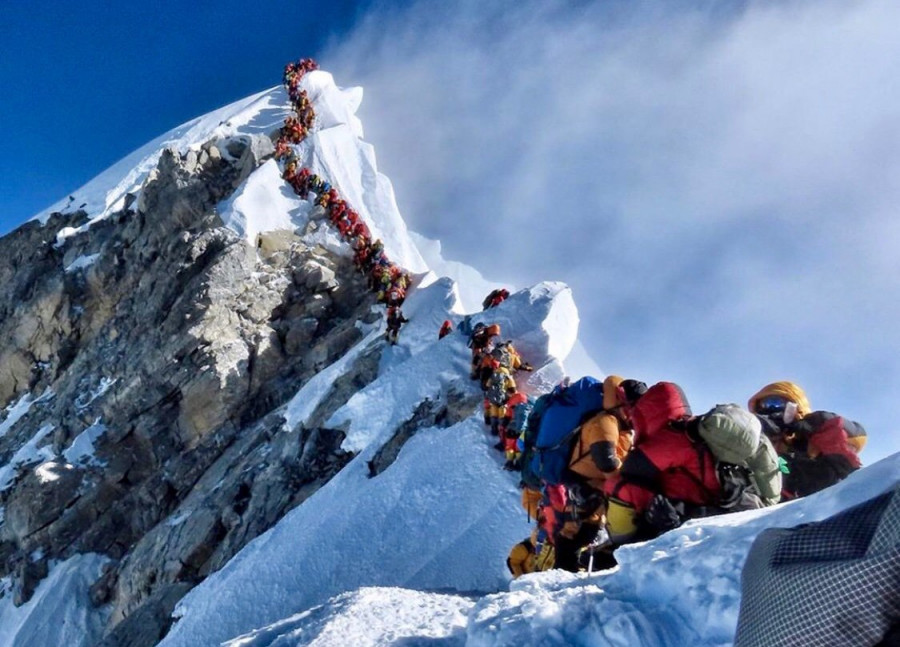National
No dissemination of pictures of others on Everest without permission
As the mountaineering season nears, Department of Tourism introduces a slew of rules to avoid controversies. These are old rules and cannot be enforced, say observers.
Sangam Prasain
A photograph of a serpentine line of climbers near the summit of Mount Everest in May 2019 went viral.
It highlighted not only the popularity of the mountain among climbers but also the risk of overcrowding and exposure to the elements at altitude above 8,000 metres dubbed the “death zone”.
Nirmal Purja, who holds the record for climbing all 14 peaks above 8,000 metres in the world in just 190 days, shared the picture with the media, and the Post too used it.
Only, he was breaking the law.
“Our law bans the dissemination of photos and videos taken on Everest without the department’s consent. But the practice has not stopped,” said Mira Acharya, director at the Mountaineering Division of the Department of Tourism. “We have [therefore] issued new rules prior to the climbing season to make them more effective.”
As the popularity of climbing the highest mountain in the world grows, there have been complaints from mountaineers that “traffic jams” near the summit pose a risk to their lives.
Although, given the Covid-19 related restrictions, there will not be overcrowding on Everest this year, and its associated risks, authorities have introduced a slew of rules to avoid possible controversies.
For one, taking, making and sharing images and videos of “other climbers” without their consent has been banned with an immediate effect.
“Each climber can take, share and make images and videos of their group or of oneself but they will face action if they take, make and share photos of other climbers without the department’s consent,” said Acharya. “We honour the personal freedom of climbers but that does not mean they can post images and videos of others without their consent. Either through commercial cameras or mobile sets, all such activities have been banned.”
If anyone intends to disseminate still photographs and videos of people, avalanches and even dead bodies on the mountain among other things, they must secure consent from the Department of Tourism, the government agency that issues Everest climbing permits.
But according to Ang Tsering Sherpa, former president of Nepal Mountaineering Association, it’s not possible to prevent the dissemination of videos or photos taken on Everest because millennials stand out for their use of technology, and even the older generation has embraced the digital life.
“You make a click here and in an instant your photo goes around the world,” he told the Post.
The ban on taking pictures is among 11 new rules the department announced on Tuesday as the mountaineering season nears. Mountaineers begin acclimatising in March and start climbing Everest in May when the weather becomes more favourable.

A total of 6,507 mountaineers have climbed Everest from the Nepal side since Tenzing Norgay Sherpa and New Zealander Edmund Hillary first set foot atop the world's highest peak in May 1953.
The year 2019 was significant in terms of records set on the world’s tallest peak. On May 22 and 23, a total of 223 and 212 climbers reached the summit, which has been recorded as the highest and the second-highest number of climbers on the top of Everest on a particular day.
There were no expeditions last year due to the Covid-19 pandemic, which caused Nepal to lose millions in revenue, while thousands of people in the mountain region were rendered jobless.
Foreigners pay $11,000 for a permit to climb Everest and spend anywhere between $40,000 and $90,000 for the entire expedition.
In 2019, the government earned $5.07 million in royalties from the issuance of climbing permits. Out of the total revenue, Everest alone accounted for $4.05 million.
Expeditions create jobs for high-altitude climbing guides, porters, base camp workers and kitchen staff.
Among the new rules that came into effect on Tuesday, expedition organisers must buy insurance coverage for the support workers by clearly mentioning their roles in the expedition.
Although the Nepali expedition support staff did have insurance earlier, expeditions used porters as mountain guides since insurance coverage for porters cost less.
All climbers applying for Everest climbing permits must also submit their medical reports issued by certified doctors to prove that they are in the physical condition to endure the hardship that climbing the highest mountain in the world demands.
“It’s a report, a proof to ensure that a person is physically and mentally fit to climb,” said Acharya. “Even if a person has cancer but he is mentally and physically fit, he can climb.”
As more and more climbers attempt to reach the top of the world, deaths on Everest have been on the rise too. In the spring of 2018, nine people died on Everest.
In the following year, 10 died on the Nepali side alone—the highest casualty since 2015.
The new rules include the provision that all climbers need to submit their detailed itinerary before applying for the Everest climbing permits.
They have to submit the details including how they arrived back in Kathmandu from the mountain during the debriefing that takes place with the department officials after the end of Everest climbing season.
The department said they have received many complaints that lazy mountaineers pretend to become ill to fly back on helicopters as they have the insurance coverage.
Following complaints of Western insurance agencies about the large number of claims for helicopter rescues, Nepal in 2018 clamped down on massive insurance fraud, which involved bogus helicopter rescues and hospital treatment of tourists, hatched by powerful brokers in trekking and mountaineering agencies.
The new rules state that the travel, tour, trekking and expedition agencies including helicopters and airlines should evacuate foreigners who fell sick in mountains only to well-equipped hospitals.
Similarly, expedition organisers should compile a detailed report of the climbs of individual mountaineers mentioning the dates of their climbs, duration of their stay at the base camp, route they used and days they reached the different camps as well as whether they reached the summit or not. The detailed report should also mention whether the climbers used supplementary oxygen or not.
These details must be submitted during debriefing. The government’s liaison officer, deployed to monitor and assist the climbers, must also be present during the debriefing session with a separate report.
“This provision will make the expedition agency and the liaison officer more accountable towards their responsibilities,” said Acharya.

There has been an increasing number of cases in the past several years where liaison officers collude with expedition organisers and climbers to award summit certificates to fake climbers.
In February, Nepal issued a six-year mountaineering ban and revoked the Everest climbing certificates of two Indian citizens who produced fake documents to claim that they had climbed Everest in May 2016.
The two Indian climbers—Narender Singh Yadav and Seema Rani Goswami—were issued certificates saying they had climbed Everest by the Department of Tourism in 2016 based on photographs and climbing reports submitted by their liaison officer.
Earlier in 2016, Nepal had also imposed a 10-year mountaineering ban on two Indian climbers Dinesh Rathore and Tara Keshari Rathore for claiming to be the first Indian couple to have climbed Everest.
They too had submitted photos to the department which apparently had been morphed.
According to the department, out of nine cases of alleged fake certificates, five, including those of four Indians and a United Arab Emirates national, are under investigation.
The department will not issue climbing permits if the expedition agencies do not fill up the online pre-briefing forms. Debriefing will be conducted only after they fill up the debriefing forms.
“This will help us ascertain the number of climbers and to put their records online,” said Acharya.
The department will begin the process of issuing Everest climbing certificates 15 days after the climbing season ends, at the end of May for the spring season and at the end of October for the autumn season.
The vast majority of climbs take place in spring.
The department will not issue the certificates to those who have not submitted the necessary paperwork.
“Majority of these rules have been implemented in order to stop the fake climbing on Everest,” said Acharya.
Expedition organisers, however, say that these are old rules.
“All rules are old ones,” said Sherpa, chairman of Asian Trekking. “The department is just trying to remind people that these rules exist.”
But, as for as the government is concerned, if all the paperwork is completed, those who reach the Everest summit will be presented with the certificates mentioning that they have reached the top of Everest, the altitude of which is 8,848.86 metres (or 29,031.69 feet) rather than 8,848 metres 29,028.87 feet) that earlier certificates said.
In December last year, Nepal and China, the two countries that Everest straddles, jointly, for the first time, declared that the height of Everest is 8,848.86 metres.




 10.12°C Kathmandu
10.12°C Kathmandu


%20(1).jpg&w=200&height=120)












